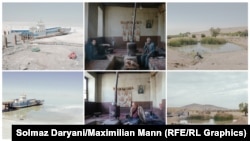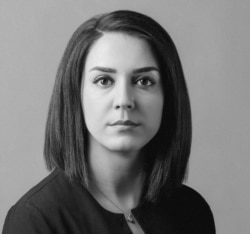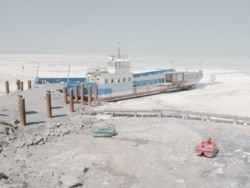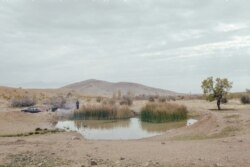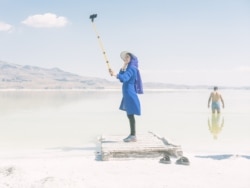After the finalists for the 2020 World Press Photo awards were announced in February, Iranian photographer Solmaz Daryani felt a flash of déjà vu.
German photographer Maximilian Mann was nominated in the prestigious photo contest for his series titled Fading Flamingoes, which captured scenes of life from the edges of Lake Urmia.
The lake in northwestern Iran has been drying up for decades, largely as a result of farmers who tap its inflowing rivers.
It’s a slow-motion environmental crisis, similar to the drying of Central Asia’s Aral Sea, which Daryani knows intimately. Her grandfather once ran a thriving motel on the shores of Lake Urmia and much of Daryani’s childhood was spent splashing in its salty water.
Beginning in 2014, the Iranian photojournalist began documenting the plight of Lake Urmia in a heartfelt picture story that links her childhood memories of the lake with its situation today. Several of her photographs are strikingly similar to the award-nominated images shot by Mann.
'This Hurts So Much'
On March 10, Tehran-based photographer Kaveh Rostamkhani wrote a blog post about the similarities between the two picture stories. The blogger quoted Daryani as saying, “As a female Iranian photographer, I have been facing so many obstacles and difficulties to carry on my work and to make it seen. Now a male photographer from Germany parachutes in and remakes a part of my project without any acknowledgement. Even worse, he manages to deprive it from its personal context. But the [World Press Photo Awards] are supporting his approach.
“This hurts so much. Eye Of The Earth is a very personal story of my family and people around the lake, and I share so many personal bonds with it,” she said. “Now it is hijacked.”
But Mann, in remarks to RFE/RL, said he did not use Daryani’s photographs for reference in his own work.
Mann told RFE/RL: “I was traveling with my [Iranian fixer Mahdi Zavvar]. He showed me the location. He knows the places very well.”
Mann said that he has received “a lot of messages with a lot of hate” since the award nominations were announced.
The Dortmund-based photojournalist also pointed RFE/RL to several images made by other photographers from the same locations as Daryani’s that are highly similar to her work.
Mann says that in some cases -- such as that of the stranded ferry -- he would be remiss not shooting a scene that so powerfully captured the story of the lake’s desiccation.
A wider selection of images from Mann’s Lake Urmia project reveals that only a handful of his nearly 100 published photographs from the lake have any visual resemblance to Daryani’s work.
Daryani has rejected the German photographer’s denial that he used her photographs as a reference: “I believe Maximilian is a talented photographer,” she told RFE/RL. “But 10 strikingly similar photographs aren't a coincidence.
“If he knew about all the other photographers’ work on the same subject, why didn't he choose a different approach?
“Ignoring a substantial work that has already been done on the same subject when one has nothing new to bring to the topic is a lack of respect and recognition and shows that the person is not sincere about the work,” Daryani said.
On March 11, the World Press Photo organization said on Twitter that it had reached out to both photographers and was “in touch with the 2020 Photo Contest General Jury to discuss the issue.”




